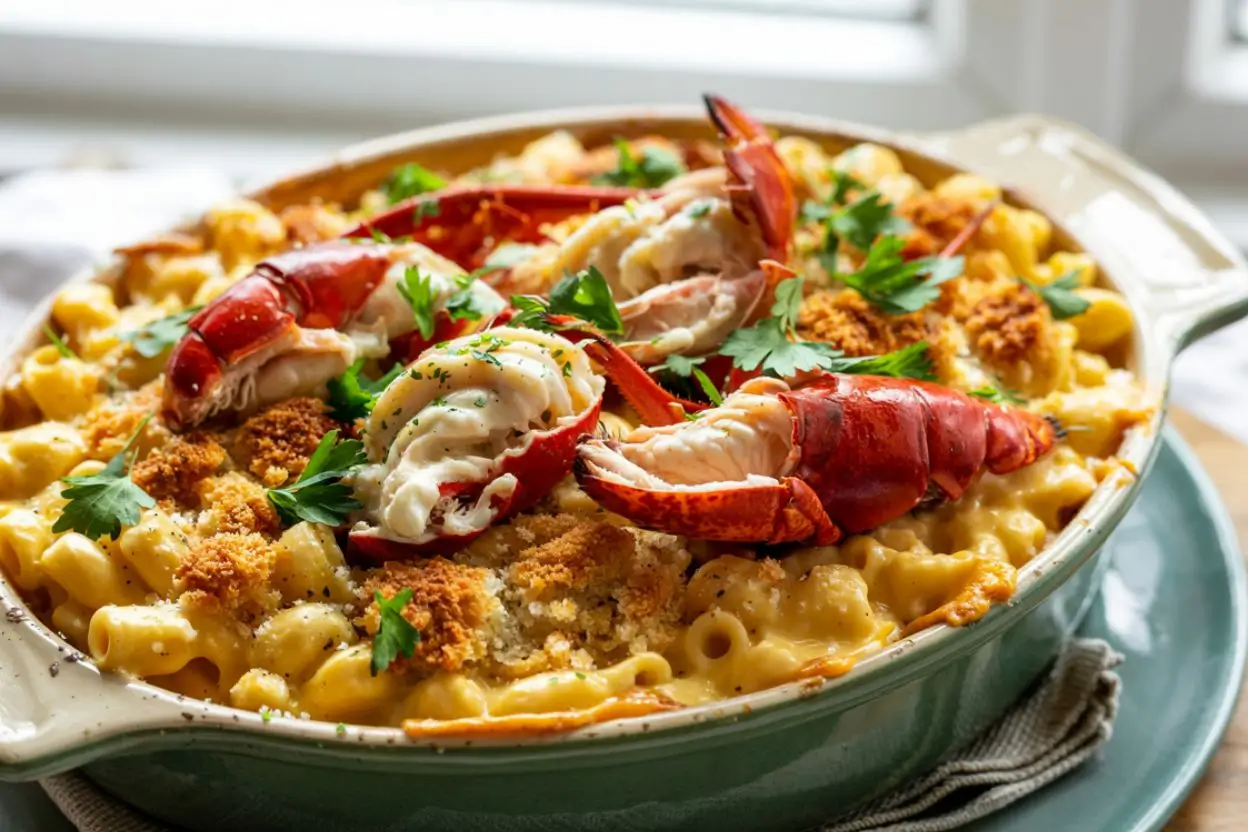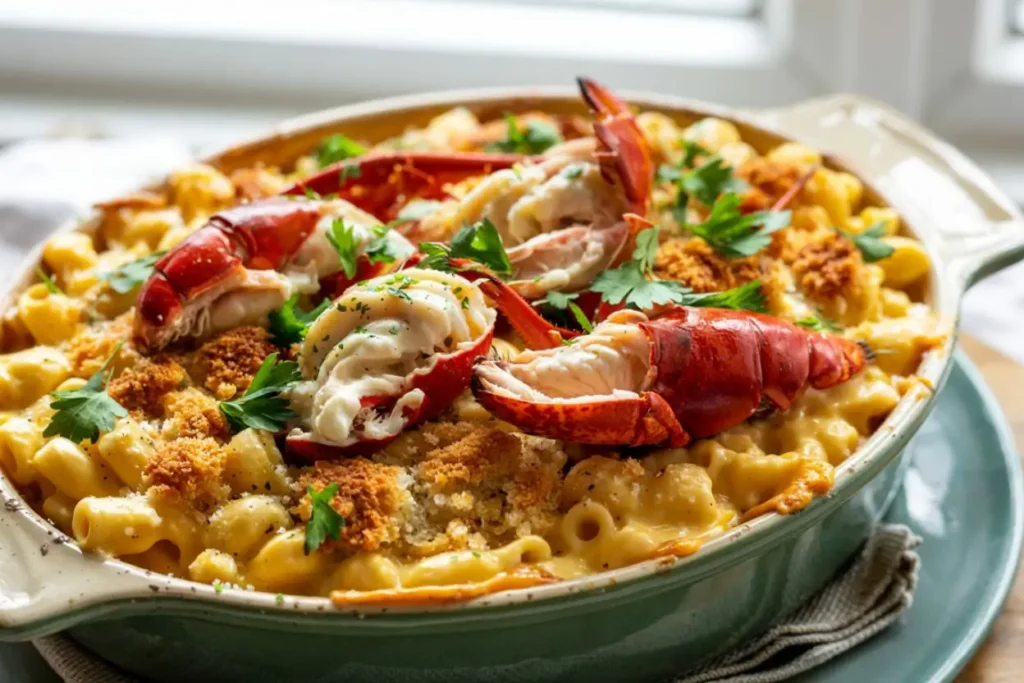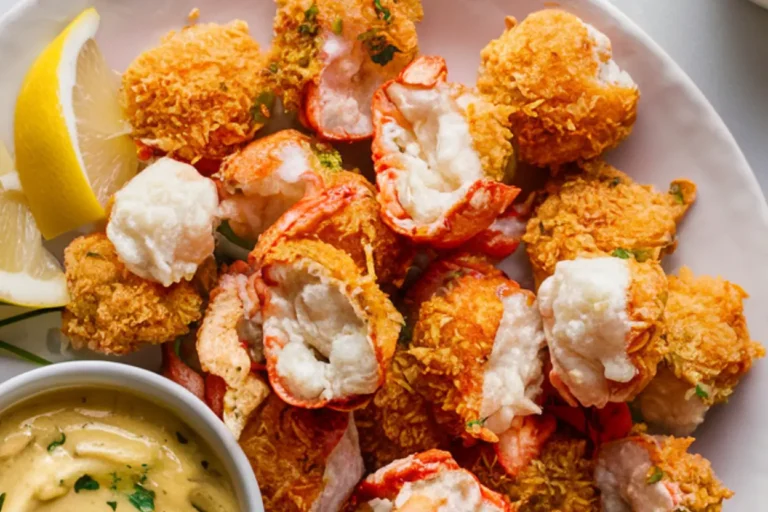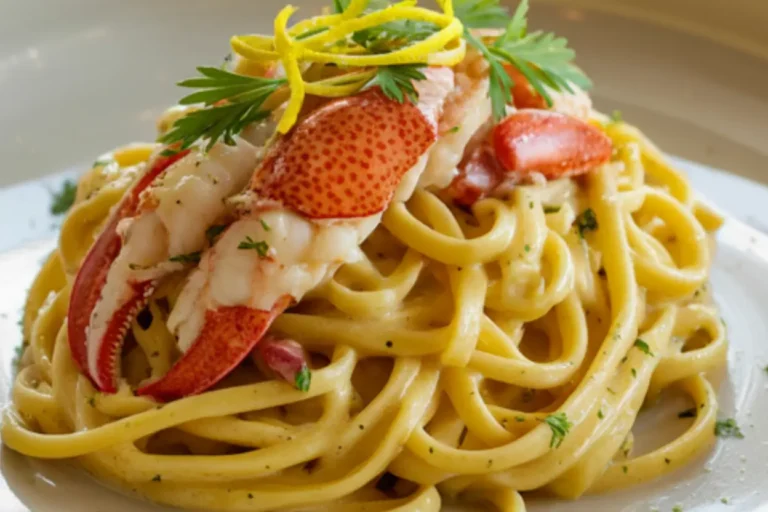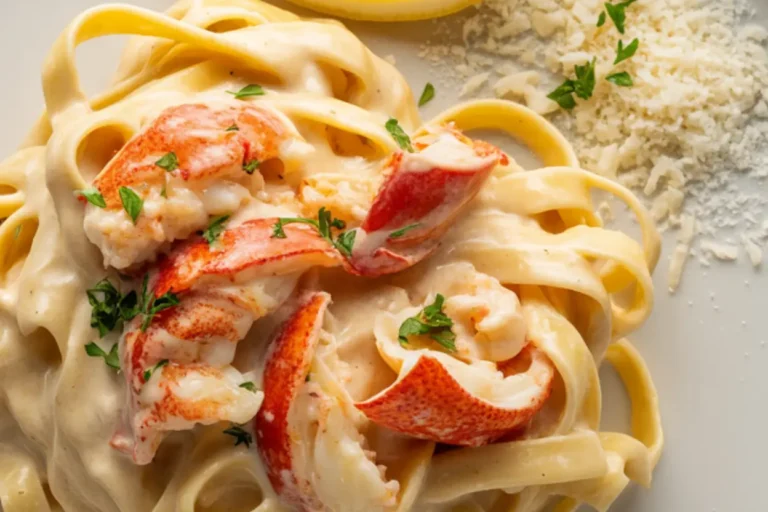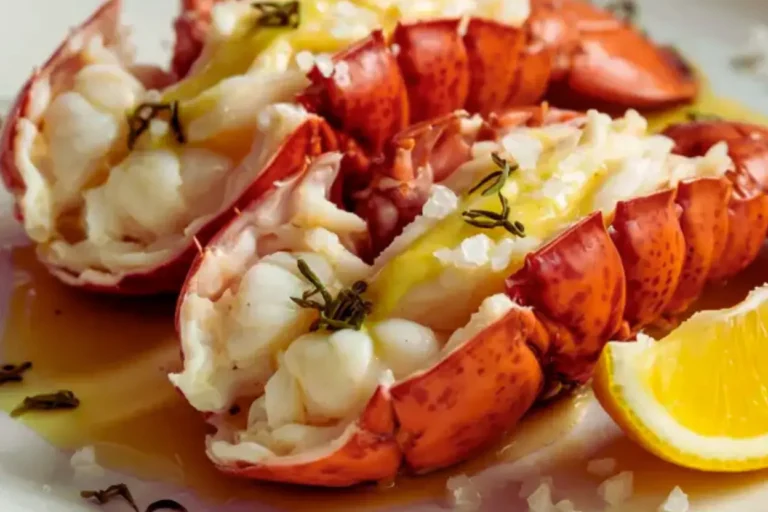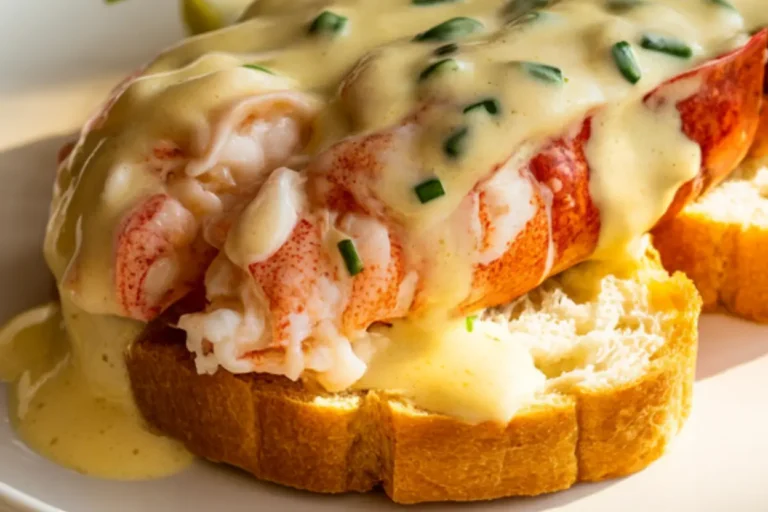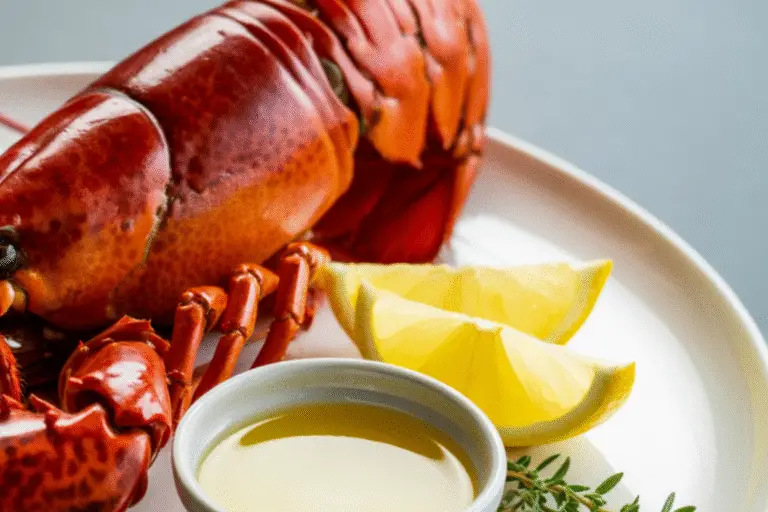Lobster Mac and Cheese Recipe: 7 Tips for Richer Flavor
Table of Contents
There’s something truly magical about the marriage of sweet, succulent lobster with creamy, cheesy pasta. This lobster mac and cheese takes comfort food to new heights, transforming a childhood favorite into an elegant dish worthy of special occasions while remaining accessible enough for an indulgent weeknight dinner.
Thank you for reading this post, don't forget to subscribe!How to Make Lobster Mac and Cheese
Quick Overview
Lobster mac and cheese strikes an ideal balance between comfort and indulgence — tender pasta coated in a rich, creamy cheese sauce, accented with sweet chunks of lobster. What sets this version apart is the thoughtful blend of cheeses, which adds depth without overshadowing the lobster’s delicate flavor, and a gentle infusion of aromatics that enhance, rather than overpower, the dish’s centerpiece.
The dish features a silky-smooth béchamel base enriched with three carefully selected cheeses, creating a sauce that coats each pasta piece perfectly. Generous chunks of lobster meat are folded throughout, ensuring you get that sweet oceanic flavor in every bite. A buttery, crisp topping adds textural contrast to the creamy interior, creating a dynamic eating experience that satisfies on multiple levels.
Despite its impressive results, this recipe is surprisingly approachable, requiring no advanced culinary techniques. The entire process takes about 50 minutes from start to finish if using pre-cooked lobster meat, making it feasible for special weeknight dinners or weekend entertaining. The hands-on preparation time is approximately 30 minutes, with the remaining time dedicated to baking until golden and bubbly.
Total preparation and cooking time: 50 minutes
Serves: 6-8 as a main dish
The Ingredients I Use to Bring My Lobster Mac and Cheese to Life
For the Pasta and Lobster:
- 1 pound (16 oz) cavatappi pasta (or medium shells or elbow macaroni)
- 1 pound cooked lobster meat, cut into 3/4-inch chunks (from approximately two 1 1/2-pound lobsters)
- 2 tablespoons fresh lemon juice
For the Cheese Sauce:
- 6 tablespoons unsalted butter
- 1 medium shallot, finely diced (about 1/4 cup)
- 1 clove garlic, minced
- 6 tablespoons all-purpose flour
- 4 cups whole milk, warmed
- 1 cup heavy cream
- 2 teaspoons Dijon mustard
- 1/4 teaspoon cayenne pepper (adjust to taste)
- 1/4 teaspoon freshly grated nutmeg
- 1 1/2 teaspoons kosher salt (adjust to taste)
- 1/2 teaspoon freshly ground black pepper
- 8 ounces sharp white cheddar cheese, grated (about 2 cups)
- 6 ounces Gruyère cheese, grated (about 1 1/2 cups)
- 4 ounces mascarpone cheese (or cream cheese)
For the Crispy Topping:
- 1 cup panko breadcrumbs
- 3 tablespoons unsalted butter, melted
- 1/4 cup grated Parmigiano-Reggiano cheese
- 2 tablespoons fresh parsley, finely chopped
- 1/4 teaspoon paprika
- 1/8 teaspoon salt
Step-by-Step Instructions
Step 1: Prepare the Lobster and Pasta
Preheat your oven to 375°F (190°C). Butter a 9×13-inch baking dish or a similar 3-quart casserole dish.
Bring a large pot of water to a boil and add 1 tablespoon of salt. Cook the pasta until it’s about 2 minutes shy of the package’s al dente instructions. Since the pasta will finish cooking in the oven, this slight undercooking helps keep it from becoming overly soft in the final dish.
While the pasta cooks, toss the lobster meat with 2 tablespoons of fresh lemon juice in a medium bowl. This brightens the lobster flavor and provides a subtle counterpoint to the rich sauce. Set aside.
Drain the pasta well in a colander and set it aside. Avoid rinsing it, as the remaining starch will help the sauce cling more effectively.
Step 2: Create the Cheese Sauce Foundation
In a large, heavy-bottomed saucepan or Dutch oven, melt 6 tablespoons of butter over medium heat. Add the diced shallot and sauté for 2–3 minutes until softened but not browned. Stir in the minced garlic and cook for another 30 seconds, just until fragrant.
Sprinkle the flour over the butter mixture and whisk constantly for about 2 minutes to cook out the raw flour taste, creating a roux. The mixture should be a light golden color and smell slightly nutty.
Gradually whisk in the warmed milk and cream, adding about 1/2 cup at a time and whisking until smooth before adding more. This gradual addition prevents lumps from forming. Once all the liquid is incorporated, continue cooking, whisking frequently, until the sauce thickens enough to coat the back of a spoon, about 5-7 minutes.
Step 3: Enrich the Sauce with Flavor
Reduce the heat to low and stir in the Dijon mustard, cayenne pepper, nutmeg, salt, and black pepper. The mustard acts as an emulsifier and flavor enhancer without making the sauce taste mustardy.
Add the grated cheddar and Gruyère cheeses one handful at a time, stirring until each addition is completely melted before adding more. This prevents the sauce from becoming grainy. Once all the grated cheese is incorporated, add the mascarpone and stir until the sauce is completely smooth.
Remove the sauce from the heat and taste, adjusting seasonings if necessary. The sauce should be rich and flavorful but still allow the lobster to shine as the star ingredient.
Step 4: Combine the Elements
Add the drained pasta to the cheese sauce, stirring gently to coat each piece thoroughly. Fold in about three-quarters of the lobster meat, distributing it evenly throughout the mixture. The remaining lobster will be used as a visually appealing topping.
Transfer the mac and cheese mixture to the prepared baking dish, spreading it into an even layer. Scatter the reserved lobster pieces on top, pressing them lightly into the surface but keeping them visible.
Step 5: Create a Crispy Topping
In a small bowl, combine the panko breadcrumbs, melted butter, grated Parmigiano-Reggiano, chopped parsley, paprika, and salt, mixing until the breadcrumbs are evenly coated with butter.
Sprinkle this topping evenly over the mac and cheese, covering the entire surface with a thin, even layer. This crispy element provides textural contrast to the creamy pasta beneath.
Step 6: Bake to Golden Perfection
Place the baking dish on a sheet pan (to catch any potential overflow) and bake in the preheated oven for 20-25 minutes, until the sauce is bubbling around the edges and the topping is golden brown.
If needed, you can broil the dish for the final 1-2 minutes to achieve a more deeply golden topping, but watch it carefully to prevent burning.
Step 7: Rest and Serve
Allow the lobster mac and cheese to rest for 5-10 minutes before serving. This brief resting period allows the sauce to set slightly, making it easier to serve in beautiful portions.
Serve immediately, with extra fresh parsley sprinkled on top if desired.
What to Serve Lobster Mac and Cheese With
Lobster mac and cheese is rich and substantial, so it pairs best with lighter, refreshing accompaniments:
- Simple Green Salad: A crisp green salad with a light vinaigrette provides a refreshing contrast to the rich, creamy mac and cheese. Consider arugula with lemon vinaigrette for a peppery, bright complement.
- Roasted Asparagus or Broccolini: These green vegetables offer a welcome textural contrast, and their slight bitterness balances the richness of the dish.
- Crusty Bread: While already carbohydrate-rich, a few slices of crusty sourdough bread can be perfect for soaking up any remaining cheese sauce.
- White Wine: A glass of crisp, unoaked Chardonnay or Sauvignon Blanc provides a refreshing counterpoint to the creamy richness.
- Champagne or Sparkling Wine: The effervescence cuts through the richness beautifully, making this an excellent pairing for special occasions.

Top Tips for Perfecting Lobster Mac and Cheese
- Choose the Right Cheese Blend: The combination of sharp cheddar, Gruyère, and mascarpone creates the perfect balance of flavor and texture. The cheddar provides familiar tangy notes, Gruyère adds nutty depth, and mascarpone brings incredible creaminess. If substituting, maintain a similar balance of sharp, nutty, and creamy cheeses.
- Cook the Pasta Properly: Always undercook the pasta by about 2 minutes, since it will continue cooking in the oven. This prevents mushy pasta in the final dish. For even better results, cook the pasta in salted water that “tastes like the sea” to season it from within.
- Lobster Preparation Matters: If cooking fresh lobster, slightly undercook it (cook for about 6-7 minutes instead of 8-10), as it will continue cooking when baked in the casserole. For pre-cooked lobster meat, gently warm it in butter before adding to preserve its texture and enhance flavor.
- Perfect Your Roux Technique: Cook the butter-flour mixture until it smells slightly nutty before adding liquid. This eliminates the raw flour taste and creates a silkier sauce. For the smoothest sauce, warm your milk before adding it to the roux and incorporate it gradually, whisking constantly.
- Layer Your Flavors: The combination of shallots, garlic, Dijon, and spices creates a foundation that enhances the cheese sauce without overwhelming the lobster. Don’t skip these seemingly minor additions, as they create depth and complexity.
- Texture Contrast Is Key: The creamy interior needs the crispy panko topping for textural interest. Make sure to thoroughly coat the breadcrumbs with butter so they brown evenly and become properly crunchy.
- Rest Before Serving: Let the finished dish rest for 5–10 minutes before serving. This short pause gives the sauce time to set, making it easier to portion and helping it adhere to the pasta instead of running onto the plate.
Storing and Reheating Tips
Lobster mac and cheese is an investment in both time and ingredients, so proper storage is essential for enjoying leftovers:
Refrigeration: Allow leftover lobster mac and cheese to cool completely before covering it with plastic wrap or transferring to airtight containers. Refrigerate for up to 3 days. The texture of the lobster may change slightly, but it will still be enjoyable.
Freezing Guidelines: While possible to freeze, the texture of both the pasta and lobster will be compromised. If you must freeze, do so in individual portions in airtight containers for up to 1 month. The sauce may separate somewhat upon thawing.
Thawing Process: Thaw frozen lobster mac and cheese overnight in the refrigerator for best results. Never thaw at room temperature, as this can lead to bacterial growth and uneven warming.
Reheating Methods for Best Results:
- Oven Method (Recommended) Preheat your oven to 325°F (165°C). Transfer the refrigerated leftovers to an oven-safe dish and cover with foil. Bake for 15–20 minutes, or a bit longer if the dish is very cold, until heated through. Uncover during the last 5 minutes to re-crisp the topping. For individual servings, 10–15 minutes should be enough.
- Stovetop Method: For a creamier result, reheat in a saucepan over low heat, adding a splash of milk or cream to revitalize the sauce. Stir gently and frequently to prevent sticking or burning. This method works best for portions without the breadcrumb topping.
- Microwave Method (Quick but Less Ideal): If short on time, microwave individual portions at 50% power in 1-minute intervals, stirring between each interval until warmed through. The lower power helps prevent the sauce from separating and the lobster from becoming rubbery. Note that the topping will lose its crispness.
Revitalizing Tips: When reheating, you can refresh the dish by adding a small sprinkle of fresh cheese on top before warming. For previously frozen portions, a few drops of fresh lemon juice brighten the flavors that may have dulled during freezing.
Food Safety Note: Never leave lobster mac and cheese at room temperature for more than 2 hours. Seafood dishes require particular care with storage and reheating to maintain food safety.
With these storage and reheating guidelines, your luxurious lobster mac and cheese can be enjoyed more than once, making the effort of preparation even more worthwhile
click here to follow me on pinterest
Lobster Mac and Cheese Recipe: 7 Tips for Richer Flavor
Cuisine: AmericanDifficulty: Moderate6-8
servings25
minutes30
minutes750-900
kcalThis indulgent take on a classic comfort dish combines tender chunks of lobster with rich, creamy cheeses and perfectly cooked pasta. Finished with a golden panko-Parmesan crust, this Lobster Mac and Cheese is luxurious, savory, and perfect for special occasions or a decadent meal at home.
Ingredients
1 pound (16 oz) cavatappi pasta (or medium shells or elbow macaroni)
1 pound cooked lobster meat, cut into 3/4-inch chunks (from approximately two 1 1/2-pound lobsters)
2 tablespoons fresh lemon juice
6 tablespoons unsalted butter
1 medium shallot, finely diced (about 1/4 cup)
1 clove garlic, minced
6 tablespoons all-purpose flour
4 cups whole milk, warmed
1 cup heavy cream
2 teaspoons Dijon mustard
1/4 teaspoon cayenne pepper (adjust to taste)
1/4 teaspoon freshly grated nutmeg
1 1/2 teaspoons kosher salt (adjust to taste)
1/2 teaspoon freshly ground black pepper
8 ounces sharp white cheddar cheese, grated (about 2 cups)
6 ounces Gruyère cheese, grated (about 1 1/2 cups)
4 ounces mascarpone cheese (or cream cheese)
1 cup panko breadcrumbs
3 tablespoons unsalted butter, melted
1/4 cup grated Parmigiano-Reggiano cheese
2 tablespoons fresh parsley, finely chopped
1/4 teaspoon paprika
1/8 teaspoon salt
Instructions
- Prep Pasta & Lobster
Preheat oven to 375°F (190°C) and butter a 9×13-inch baking dish. Boil pasta in salted water until just shy of al dente, then drain (do not rinse). Toss lobster meat with lemon juice and set aside. - Start the Cheese Sauce Base
Melt butter in a large saucepan, sauté shallots for 2–3 minutes, then add garlic for 30 seconds. Whisk in flour to make a roux and cook for 2 minutes. Slowly add warm milk and cream, whisking until smooth. Simmer until the sauce thickens (5–7 minutes). - Add Cheese & Flavor
Reduce heat to low. Stir in mustard, cayenne, nutmeg, salt, and pepper. Gradually melt in cheddar and Gruyère. Add mascarpone and stir until smooth. Taste and adjust seasoning. - Combine Pasta, Lobster & Sauce
Stir pasta into the cheese sauce, then fold in ¾ of the lobster meat. Transfer to a prepared baking dish and top with the remaining lobster. - Make the Topping
Mix panko, melted butter, Parmesan, parsley, paprika, and a pinch of salt. Sprinkle evenly over the mac and cheese. - Bake Until Golden
Bake for 20–25 minutes until bubbling and golden. Broil for 1–2 minutes if needed for extra color—watch closely to prevent burning. - Rest & Serve
Let rest for 5–10 minutes before serving. Garnish with extra parsley if desired, and enjoy warm.
Notes
- This dish elevates traditional mac and cheese with the addition of lobster and a trio of cheeses: sharp white cheddar, Gruyère for meltiness and nutty flavor, and mascarpone for silky richness. The Dijon, cayenne, and nutmeg add subtle warmth and depth. Topping it with buttery panko and Parmigiano-Reggiano gives it that perfect crisp bite. Great for dinner parties or special nights in, it’s a luxurious twist on a familiar favorite.

